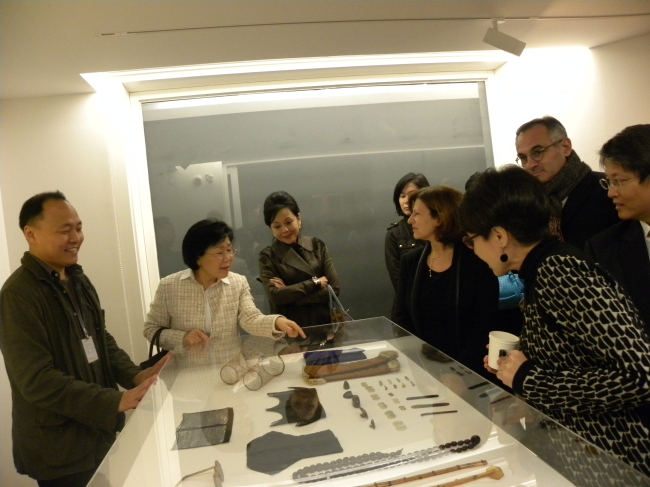 |
Members of CQ and CICI president Choi Jung-wha (second from left) view a collection of Joseon-period men’s accessories on display at “Po, the Seonbi Spirit in Clothing,” exhibition at Areumjigi Culture Keepers Foundation building in Tongui-dong, Seoul, Tuesday. (CICI) |
A group of 23 foreign envoys, foreign CEOs and Koreans were treated to a special tour of Areumjigi Culture Keepers Foundation in Tongui-dong, Seoul, Tuesday night.
The visit to the newly opened Areumjigi headquarters and the ongoing exhibition “Po, the Seonbi Spirit in Clothing” was part of the curriculum of Korea CQ, a 10-week program run by the Corea Image Communication Institute that introduces its members to various aspects of Korean culture.
The visitors were led through the second floor where several recreations of “po,” or the literati’s outer robe, from the Joseon period, are on display. The pieces that range from a gossamer ivory colored piece made from fabric woven with ramie and silk, to a luxurious silk durumagi, the most common form of po, lined inside with fur, were an eye opener for the visitors.
“Contrary to commonly held preconceptions, seonbi were not dour,” said Jang Young-suk, the foundation director. If, indeed, clothes speak volumes about the wearer, the literati of Joseon were anything but solemn and stern. A translucent pale pink robe would have made any scholar a dandy.
Contemporary clothing by three well-known Korean designers that have been inspired by the seonbi spirit are on display on the first floor. Not literal reinterpretations of traditional clothing, the coats and jackets have a refined, dignified mood that seems to reflect the spirit of Joseon-period Confucian scholars.
“This is very alive, not a dusty museum. It is something to enjoy in the 21st century. Culture can be alive and not only in history books,” said Vincent Bernard, Country General Manager of Christian Dior Couture Korea.
The tour was also an opportunity to learn about hanok, especially the science behind the traditional building. For example, the central dirt courtyard was kept empty of plants or other ornaments so that in the summer time, the heat from the ground would rise, allowing a cooler breeze from outside to blow in through the wide open mulberry paper windows.
The visitors responded enthusiastically to the Areumjigi headquarters building, a unique mix of hanok and modern building. In fact, Areumjigi is known for its efforts at making hanok relevant to contemporary living.
From the outside, the building looks thoroughly modern, providing an interesting contrast to the Gyeongbokgung Palace that is just a few meters away, across a narrow road.
A pleasant surprise is to be discovered on the second floor where a hanok structure is situated and across from it, a linear structure that runs parallel to the hanok. The stone courtyard reflects the courtyard found in traditional homes.
Omar Nahar, Jordanian ambassador to Korea, noted the mix of old and new in the building, drawing a parallel to the forward outlook of Korea while it attempts to maintain the past.
The juxtaposition of old and new was also noted by James Bemowski, vice-chairman/CEO of Doosan Corporation.
“It is a beautiful blending of traditional and contemporary architecture in the same space. There is a lot of peacefulness created in a special place,” he said.
By Kim Hoo-ran (
khooran@heraldcorp.com)






![[Herald Interview] 'Trump will use tariffs as first line of defense for American manufacturing'](http://res.heraldm.com/phpwas/restmb_idxmake.php?idx=644&simg=/content/image/2024/11/26/20241126050017_0.jpg)
![[Health and care] Getting cancer young: Why cancer isn’t just an older person’s battle](http://res.heraldm.com/phpwas/restmb_idxmake.php?idx=644&simg=/content/image/2024/11/26/20241126050043_0.jpg)
